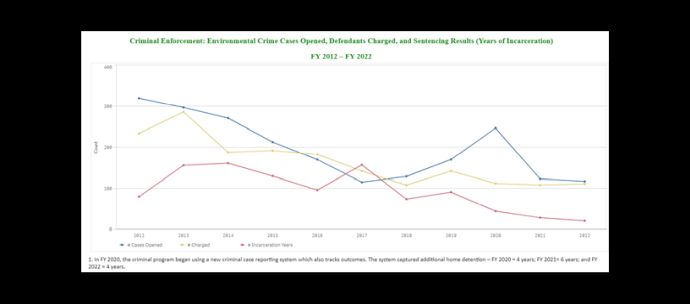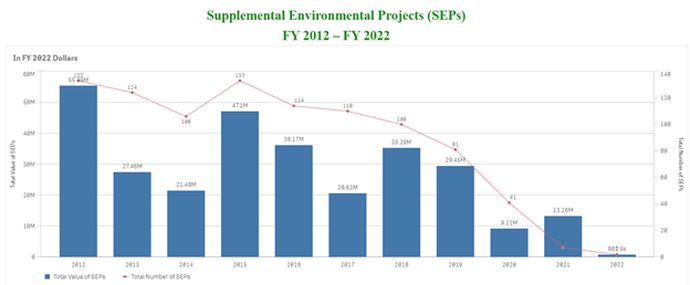- with readers working within the Property industries
- within Litigation, Mediation & Arbitration and Corporate/Commercial Law topic(s)
Rebounding from the COVID-19 pandemic, many observers wondered whether environmental enforcement cases would increase in 2022. With another year under its belt, the Biden EPA has had more time and stability to pursue its policy objectives and adjust enforcement priorities. Recent announcements and data released by the EPA suggests that as the Biden agenda becomes more entrenched, EPA and DOJ are prioritizing enforcement cases involving energy interests, particularly in areas of environmental justice ("EJ") concern, even as the total number of federal environmental enforcement cases continue to gradually decline consistent with long-term trends.
EPA's enforcement program is currently guided by National Compliance Initiatives ("NCIs") last updated in 2019. Those initiatives include focusing compliance and enforcement efforts aimed at, among other things, cutting air and water pollution and preventing accidental releases at industrial and chemical facilities. Late in 2022, EPA announced plans to update the NCIs to guide EPA's enforcement work for 2023-2027. That update is likely to align the NCIs with EPA's recently revised strategic plans targeting EJ communities and climate change.
Data from EPA suggests that overall case initiations and conclusions remained fairly steady in 2022, in line with enforcement trends over the last decade. In 2022, for example, EPA initiated 1,656 and concluded 1,648 civil judicial and administrative cases, a slight uptick in total civil enforcement activity compared to prior years (e.g., 1,562 cases initiated and 1,603 cases concluded in 2021; 1,562 initiations and 1,599 conclusions in 2020).
On the criminal side, enforcement numbers continued a downward trend from last year. 2022 saw the fewest number of criminal cases opened since 2017 – 117 cases – and by far the fewest total years of prison sentencing in EPA's dataset. Last year, we noted these trends were not in line with the anticipated ramp-up in criminal enforcement activity expected to accompany the Biden administration. The reasons for continued declines in criminal cases is subject to debate. What is clear, however, is that the Biden administration is increasing its enforcement focus on operations in areas with potential EJ concerns.


In conjunction with EPA's memo, Strengthening Enforcement in Communities with Environmental Justice Concern, EPA has significantly increased its monitoring efforts in areas of potential EJ concern, which has in turn concentrated enforcement in those areas. In 2022, nearly 57% of on-site inspections occurred at facilities affecting communities with potential EJ concerns, exceeding the goal established in EPA's Strategic Plan, which aims for 45% of EPA's on-site inspections to be conducted in such areas by 2026. Of the 1,648 civil judicial and administrative cases concluded by EPA in 2022, over 44% address facilities in such areas, the highest percentage in EPA's recorded history. And though the government assessed only $154 million in total administrative and civil judicial penalties in 2022 – compared with $1.14 billion in 2021 – $40 million of those penalties were assessed in areas of potential EJ concern, among the highest proportion since EPA began tracking EJ statistics.
However, EPA collected substantially less estimated value of injunctive relief in 2022 than in 2021 – from $2.6 billion in 2021 to $514 million in 2022. Further, EPA recorded a 20-year low in the number of concluded civil judicial cases in 2022 – 72 – well below the previous administration's average of 94 cases per year. While enforcement numbers have been trending downward, a significantly higher percentage of efforts have been concentrated in areas of potential EJ concern. For example, 26% of assessed penalties in 2022 were from areas of potential EJ concern; in 2021, that percentage was only 3%.
Perhaps surprisingly, supplemental environmental projects ("SEPs") and third-party payments did not play a significant role in EPA's arsenal in 2022. In fact, in 2022, EPA concluded only two enforcement cases that included agreements by the violator to perform SEPs, the lowest number in EPA's dataset. The total value of SEPs in 2022 amounted to just over $802,000, also the lowest total in EPA's dataset. For reference, EPA's previous low came in 2020, when it assessed approximately $9.21 million in SEPs, representing an eleven-fold decrease in value from 2022 to 2020. When EPA and DOJ restored SEPs as an enforcement tool in May 2022, many expected SEPs to again become a significant factor in settlement agreements. However, the use of SEPs and third-party payments remains controversial, and overly expansive uses of these tools may draw attention from oversight committees in the House of Representatives. Moreover, existing DOJ policies still require a "strong connection" between the supplemental environmental project and the environmental violations at issue in the case. Despite the low numbers, we expect EPA to increase its use of SEPs in 2023.

Environmental enforcement numbers continued to gradually decline in 2022. However, it has become clear that the Biden administration is committed to concentrating enforcement in EJ communities. It remains to be seen whether this downward trend of enforcement action continues into the future or whether EJ concerns will continue to drive enforcement decisions. Presently, President Biden's nominee to lead the EPA Office of Enforcement and Compliance Assurance (OECA), David Uhlmann, continues to await confirmation by the Senate. Looking ahead to 2023 and 2024, companies should be prepared to encounter more exacting scrutiny from EPA and DOJ for operations in areas of potential EJ concern. Such facilities should expect more inspections and heightened monitoring while preparing to face a higher likelihood of federal enforcement interest.
EPA's 2022 report and Enforcement Annual Results can be found here.
The content of this article is intended to provide a general guide to the subject matter. Specialist advice should be sought about your specific circumstances.


